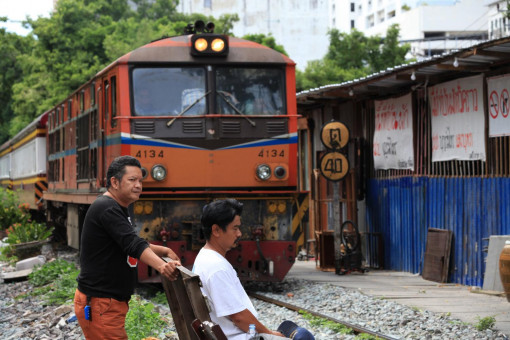Families must move to make way for high-speed SRT project, writes Supoj Wancharoen

Chao Kerdaree sits on a bench between two rail tracks, facing a row of shanty houses. Soon his family and another 100 more will be forcibly evicted from their Bun Romsai community built along a one-kilometre rail track in Phaya Thai district.
“I’ve lived here for more than 20 years. Our community was established more than five decades ago but when we are told to leave by the landowner (the State Railway of Thailand), we have to go. We don’t have other options,” said Chao, the community leader.
The Bun Romsai community can be accessed via Phetchaburi Soi 5 and is about 800 metres away from Phaya Thai BTS station.
The community is part of an area where the Don Mueang-Suvarnabhumi-U-Tapao high-speed rail route will be built.
The 224-billion-baht high-speed rail project is part of the Eastern Economic Corridor (EEC) to connect three airports, Don Mueang Airport in Bangkok, Suvarnabhumi Airport in Samut Prakan and U-Tapao Airport in Rayong.
SRT awarded construction of the high-speed rail project in 2019 to the Charoen Pokphand Group-led consortium called AERA1.
The project is expected to boost economic development and create more than 100,000 jobs after it opens in 2029, says the Transport Ministry.
The SRT needs to clear the land for the project. Bun Romsai and the other two communities, or 300 families in total living along the Eastern Line railway, must also move, according to SRT.
Even though people have lived on the land for more than half a century, the Bun Romsai community has never been registered in Bangkok’s system because the community is built on public land.
It is believed the community was started by staff or former staff of the SRT, said Asst Prof Boonlert Visetpricha, a lecturer of Sociology and Anthropology at Thammasat University. They built houses on the vacant land to be close to their workplaces.
When other poor people learned that they too could live in the area, they also built houses there, he said. They were not land encroachers but they were settlers, he said.
“They are low-income earners who struggle to live in the capital. But they play an important role in society as they sell workers low-cost food or snacks.
“Society needs them as one of the gears to keep things running,” he said.
Mr Chao is a motorcycle taxi driver who provides services around the Phaya Thai area.
He settled into the community 20 years ago when he said his family could not afford to rent a room in the capital.
“I built my home here because we could not pay for rent. I used to work in a factory but I’m now a motorcycle taxi driver. My wife has a stall selling grilled pork balls.
“Our combined earnings are 20,000 baht a month. Although it is not much, we can pay for our two sons’ study, one in Matthayom 5 (Grade 11) and the other who has now graduated from vocational school,” he said.
Phob Raksitanont, another resident, said he was born in the nearby Daeng Bu-Nga community before moving to the Bun Romsai community after the landowner in Daeng Bu-Nga sold the land. He is a motorcycle delivery man.
He lives with his wife who has a job as a maid in a nearby office building, his parents and his aunt. The family makes 20,000 baht a month.
When SRT told the 150 families in the Bun Romsai community to leave the land in January 2020, the first reaction among locals was that they did not want to move because they have nowhere else to go.
“We negotiated with the SRT. We even met the SRT’s governor (Nirut Maneephan). He told us he will find a win-win situation,” said Mr Chao.
“But in 2021, some of us received removal warrants from the court,” he said.
After locals protested, Mr Chao said the SRT agreed to work with the Community Organisation Development Institute to build a new community for them and others who need to be relocated.
They will move to a low-cost housing estate in Soi Mo Leng, near the Makkasan Reservoir, which is about 2km away from their community.
The new housing project is expected to start next year and will be completed by 2025.
In the meantime, locals asked the SRT to build temporary shelters for them when their houses are demolished.
For those who do not want to live in the low-cost housing project, the SRT will offer them compensation for their house’s demolition.
Mr Chao said about 200 out of 300 families living in the affected communities including Bun Romsai decided to take the offer while the others decided to stay and wait for their new homes.
“We have lived here for so long and have a stable income here. We have developed our community, once known as a hotbed of crime many decades ago, into a peaceful home,” he said.
“As low-income earners in a big city, we only need an affordable place to live,” said Mr Chao.

